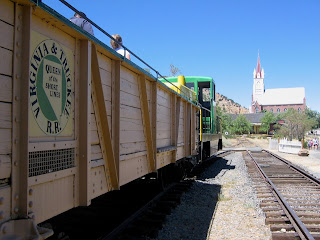Few things are as relaxing as a soak in a warm pool of water. Doing so certainly makes one accept that—as was widely believed in the 19th century— natural hot springs have recuperative powers.
Fortunately, there are several natural hot springs in this area including Grover Hot Springs State Park, located six miles west of Markleeville, California.
Situated in the picturesque (and appropriately-named) Hot Springs Valley, the park offers camping, hiking, fishing, and, of course, dips in warm spring-fed pools.
There are two developed pools at the park (one is older and more rustic in appearance, while the other looks like a modern swimming pool).
Both are fed by the runoff from six mineral springs that are located uphill from the pools. The water leaves the ground at about 148 degrees Fahrenheit and then is cooled so the temperature in the pools remains between 102 and 104 degrees.
Excess water and overflow from the pools are diverted into nearby Hot Springs Creek, a year-round stream that passes through the center of the park’s large meadow. During the summer, visitors can fish the creek, which is stocked with trout.
While long used by native people in the area, the springs were claimed in the early 1850s, when rancher John Hawkins took up squatter rights in the meadow adjacent to the springs.
In 1878, Hawkins sold his property to the Grover family, who maintained a dairy on the property and operated the Fisk Hotel in Markleeville. The Grovers developed the springs into a resort and began shuttling customers from their hotel to the springs.
The land was acquired by the California State Parks system in the late 1950s and developed as a park with campgrounds and trails.
Historically, the pools have been thought to restore health. Both the Washo Indians, who were the first to settle around Lake Tahoe and the Carson City area, and the later pioneer white settlers believed the water could cure a variety of ailments.
The hot water’s mineral content is a bit unique. It is mostly sodium carbonate, sulfate and chloride and includes almost no sulfur, which is somewhat rare for a natural hot spring.
In addition to the hot springs pools, the 519-acre state park offers several worthwhile hiking trails including the Burnside Lake trail. Accessed at the extra-vehicle parking lot, it runs the length of Hot Springs Valley. It features a side trip to a waterfall and leads to Burnside Lake (5.5 miles away).
Scenic mountains surround the park on three sides, so the place has a kind of cozy, protected feeling. The highest point is Hawkins Peak, at 10,023 feet, located three miles to the northwest, while four miles south is Markleeville Peak at 9,417 feet.
Grover Hot Springs State Park boasts two campgrounds with piped water, restrooms with showers, stoves, cupboards and tables. The two, called Quaking Aspen and Toiyabe, have only 75 sites, so reservations are urged by the California Park Department (at www.parks.ca.gov or by calling 800-444-7275.
Grover Hot Springs State Park is located 42 miles southwest of Carson City via Highway 395 and Highways 89 and 88 (through Markleeville). For more information, go to: https://visitlaketahoe.com/parks/grover-hot-springs-state-park/.






















